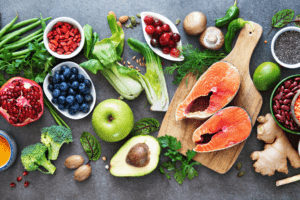
Precision Nutrition introduced us to the traffic light eating method.
This system can help you define your own “green light,” “yellow light,” and “red light” foods based on how they work for you. Spoiler alert: “Red light” doesn’t mean bad.
Quality nutrition is important in choosing foods—but you also have to factor in your likes and dislikes, habits, goals, and mindset.
Green light foods = anytime, anywhere foods
These are foods you eat regularly and with ease. You can eat them normally, slowly, and enjoy reasonable servings.
A lot of whole foods usually make up most of this list, but your list may also have foods that you enjoy just because, in amounts that work well for you.
Nutrient density isn’t the only criteria here: Your “green lights” are foods that you enjoy, fit with your culture and lifestyle, and that make you feel great physically and mentally when you enjoy them!
Yellow light foods = “sometimes” / “maybe” / “smaller dose” foods
Your “yellow lights” are foods you might eat occasionally, with awesome caution or more mindfulness.
Maybe they trigger a bit of indigestion (but not a full-scale emergency trip to the restroom).
Perhaps you prefer to enjoy them in small, bite-sized doses. Or only on certain occasions, like out at a restaurant with friends.
It’s worth noting that yellow light foods don’t have to be “problem” foods.
Red light foods = foods you typically avoid, minimize, or make less available
Red light foods aren’t bad. They’re just foods that you choose not to eat (at least most of the time).
Here is why some Red light foods might not work for you:
- They don’t help you achieve your goals
- You tend to overeat them
- You’re allergic to them
- You can’t easily digest them
- You just don’t like them
- Ultra-processed foods often fall into this category since many folks find that, once they start eating them, they can’t stop. Some people even call them “trigger foods,” because after taking a single bite, they blink, and the couch is covered in Dorito dust and empty ice cream cartons.
This doesn’t mean you avoid these foods all the time.
You might not want to keep the freezer stocked with Cherry Pie, but perhaps you’ll happily enjoy a generous slice on a special occasion.
At the same time, so-called “healthy” foods can wind up on the red light list too.
If green beans makes you gag, put it on the red light list. ( who wants to eat foods they hate?)
If eggs cause you to break out in hives, that’s a red light.
If plain, baked chicken breast makes you feel like a deprived dieter, you guessed it—red light food.
Worth noting again: Just because it’s on your Red light list doesn’t mean you can never eat it again. In fact, unless you have severe allergies, it can be worth experimenting with now and then.
You might grow to love something you currently dislike. Or become better at eating it in moderation.
I personally have been able to move many foods from my red light list to my yellow light list. Give it a go! You just might like their traffic light method.
Be the first to comment